Every States COVID Numbers, July 2021 (Emergency Use Authorization)
I swore that I was going to stop doing these, but the landscape on COVID info is atrocious and wildly out of context
I said I was going to stop doing these posts, but it seems like the nature of the news cycle these days is to default to wild and hyperbolic COVID news when nothing else seems to be happening. I finally got fed up with all the out-of-context data and decided it was time for another state-by-state COVID report.
Interestingly, it is almost 1 year to the day since I initially got frustrated with the slap-dash and contextless nature of COVID reporting and did my very first “Every State’s COVID Numbers” piece. It’s hard to believe that was only a year ago, yet here we are.
Due to circumstances beyond my control, I won’t be able to respond to this post or do any further COVID analysis for the next few weeks, which is all the more reason to try to get this out so that there is some decent perspective to the news stories that seem so allergic to context.
Summary
We’re going to stick the summary up front because it’s the most important part of this post.
Yes, there are some COVID surges happening in the US and that’s never great. But those surges are much slower and lower than we’ve seen previously and there has not yet been the now-familiar corresponding death surge. The good news is that (despite what you may read in the press) COVID vaccinations are quite high, especially among the vulnerable.
The following is not so much objective new than my opinion: There is obsession in the press to look at small vaccination differences and treat them like large ones. The United States as a whole is 68.6% vaccinated with at least one dose. The lowest state is almost at 50%, but has still vaccinated 78% of their senior population. When you look at the Kaiser monthly vaccine monitor, you see that almost every variable that raises the risk of COVID (living in a population-dense city, age, having a dangerous co-morbidity) corresponds to a higher rate of COVID vaccination. We’ve targeted the highly-vulnerable and let the medium-vulnerable make their own choices (most have chosen to get vaccinated). As a result, I expect we’re going to start seeing COVID surges that look more like the UK’s recent surge.
As you can see from the chart, the UK has recently had a fairly substantial COVID surge. As the numbers were climbing, I waited and waited for COVID deaths to match the climbing case rates. They never did. Yes, deaths “doubled” in a few weeks, but the doubled from 1.1 to 2.2 deaths per 10 million whereas the previous surge saw deaths soar to almost 36 deaths per 10 million.
We have seen a small increase in COVID deaths in Missouri, but we really need to see this in context. I’ve cobbled together a chart showing the first COVID wave in New Jersey (March-May 2020) vs the second wave in California (Dec 2020 - Feb 2021) vs the third wave in Michigan (March-May 2021) vs the current Missouri surge.
I believe that the Michigan surge would have been substantially worse if they had not had vaccines already going out the elderly and vulnerable. Given the rate of COVID cases, it had a very shallow rate of death, indicating that most of the people who tested positive were healthy individuals who had not yet gotten the vaccine and were able to recover on their own.
It might be too early to say the same for Missouri, but the initial numbers nod in that direction. If Missouri’s case surge peaks in the next few weeks, we may be looking the future of COVID: occasional sharp case surges accompanied by a shallow death curve. This is what we’re seeing in the UK and it’s exactly what we hoped the vaccine would bring to us.
Even a moderately vaccinated population is in a vastly better place to combat COVID than the most stringently locked-down state in the pre-vaccine era. I would certainly expect that, over time, we would see better results from more vaccinated regions because of the mathematics of vaccine efficacy, but I don’t suspect the differences between a region that is 60% vaccinated and 75% vaccinated to be particularly high. The best “bang for your buck” in reducing risk has already been largely achieved in the vaccination of the elderly and vulnerable.
If you are still looking for protection against COVID, my main recommendation is that you get vaccinated. Even a single shot provides substantial protection. This protection vastly out-strips all other forms of COVID mitigation, including masks. If you’re an adult and worry about your COVID risk profile, vaccination is the way to go.
Context
For the purpose of context, here are two charts from the recent winter surge. To help everyone feel comfortable with whatever bias you prefer, you can compare the current situation to either the red states along the southern border or the blue states in the northeast.
Keep this scale in mind to see exactly what is happening in our current surges.
Midwest
The biggest current surge is happening in Missouri and doesn’t seem to be happening in any of the other midwestern states (which seem to have more in common with the patterns in the Northeastern states at the moment.
Interestingly, Missouri was entirely exempted from the recent midwestern March-April surge. This is a pattern we see pretty often: A state somehow misses a regional surge only to see a later surge that is out of sync with it’s region (we saw this with New Mexico last fall).
Even with the ongoing surge, Missouri’s death rate is less than a third the death rate in Michigan from the most recent surge. Since MO and MI are vaccinating at similar rates (both were at 35-40% vaccinated in April and are currently at about 60% vaccinated) I suspect this is an indication of how much more protection a state gets with an additional 20-25% of the population vaccinated. It seems to be a lot.
Mountain States
I keep hearing about huge case surges in Utah and I honestly don’t understand why I’m not hearing about case surges in Nevada. Regardless, neither of these surges are really that big right now. I’m sure they could go higher (I take the UK as a cautionary tale), but this is not currently a deeply alarming development, especially since death rates are quite flat.
Northeast States
It’s always good to see a region doing as unambiguously well and the northeast is. I suspect a combination of high vaccination rates and the fact that this dip in COVID during the summer is exactly the seasonal pattern we saw last year (see image below).
If the northeast does follow the seasonal pattern, we should expect cases to stay low through the summer and early fall and head back up in mid-to-late October. But, given where vaccination rates currently are and the amount of runway they have before another seasonal surge, they may end up forestalling another case surge.
Southern Border
I find this pair of charts stunning. We can see that there is a fairly recent rise in cases in the southern border states but it is both far lower than the summer surge last year and is so far accompanied by no discernable increase in daily COVID deaths. I can’t imagine this could continue except that I couldn’t imagine that the death rate would stay low in the UK given the spike in cases and yet it did.
I think it’s too early to say definitively that we not going to see the now-familiar death surge in the next month, but it’s never too early to hope. It is worth pointing out that the media frenzy around these surges is fairly disconnected from the actual data we see coming in. I’ll watch these numbers closely & report in a month or so, but what we see here is good news to be accepted cautiously.
Mid-South
I’m entirely uncertain why Arkansas along in this region is seeing a case surge. Last year, they surged almost perfectly in line with most of the other states of the mid-south region. The only pattern I could suggest is that, like Missouri (whom they border), they were unique to their region as the only state that was spared the March-April surge entirely. We also see what could be the beginnings of a surge in several other southern state, though the numbers are not particularly high.
In the death numbers, Arkansas has the pattern we saw in the UK chart above where their death numbers have doubled but remain compared to previous surges.
Plains States
Not much going on in the plains states on the COVID front. There is a minor surge in Kansas and Oklahoma, but the case numbers are still low for a surge and the death rate has been stable for months. We can keep an eye on it, but there isn’t much going on at this moment.
West Coast
California has always been a complicated state when talking about COVID because the southern part of the state moves more in line with the Southern Border region and the northern part of the state moves more like Oregon and Washington. We see cases tilting upward in this region, but shallowly and not very high. The death numbers are incredibly stable and have been for a few months. I suppose the recent increase could be due to the heatwave in the Pacific Northwest, but if that is the case, the impact of the heatwave was far less than I would have expected. It could just be semi-random case variation.
Upper Northeast + Alaska & Hawaii
I find Hawaii’s mini-surge to be a particularly interesting data point that I will certainly keep my eye on. Why? Because Hawaii is one of the highest vaccinated states with 84.3% of the adult population vaccinated and all of their senior population (99.9%) vaccinated. If that isn’t enough to drive COVID numbers down to zero, the such a target is clearly inaccessible. Even as Hawaii has hit my “caution line” metric of 10 cases per 100K residents, I’d surprised to see deaths increases over the next few months.
We’ll see in a few weeks if the surge in Alaska is a temporary or ongoing concern. I suspect it will look much like Missouri by the time it is over.
If you’d like to compare these surges with previous surges, my “states in context” series can be found here
Looney Tunes: A Hare Grows in Manhattan
This cartoon starts out as some kind of episode of “Lifestyles of the Rich and Famous” as it surveys a posh Hollywood neighborhood only to land on the simple rabbit hole, waking Bugs from his sleep. Upon seeing the press at his door, Bugs puts on airs and comes to recount his rough-and-tumble youth in Manhattan. This is all the intro we need to set the stage for a fairly standard Bugs short that is Bugs vs Street Thug Dogs, though most of the gags are against only the leader of the street thugs.
I confess to not really enjoying this one. It wasn’t bad, there are just a lot better Looney Tunes. Nothing about this one really stuck out as clever or unique.





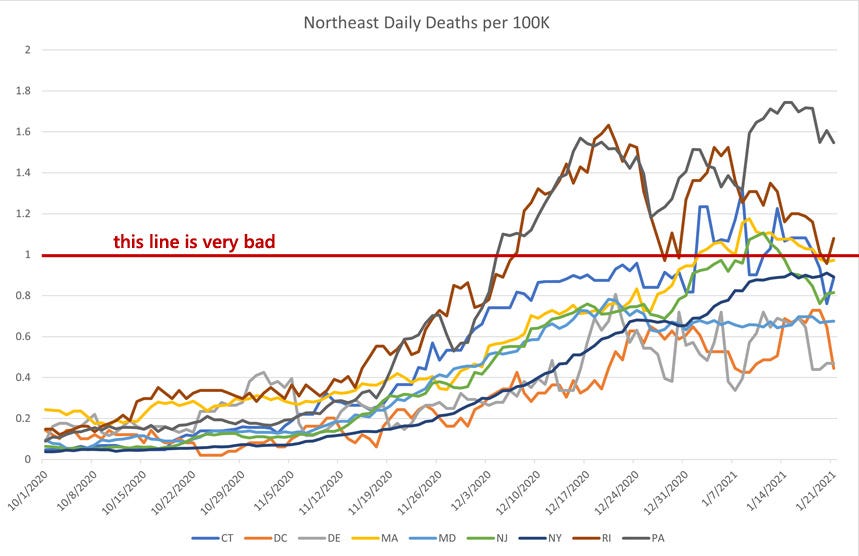


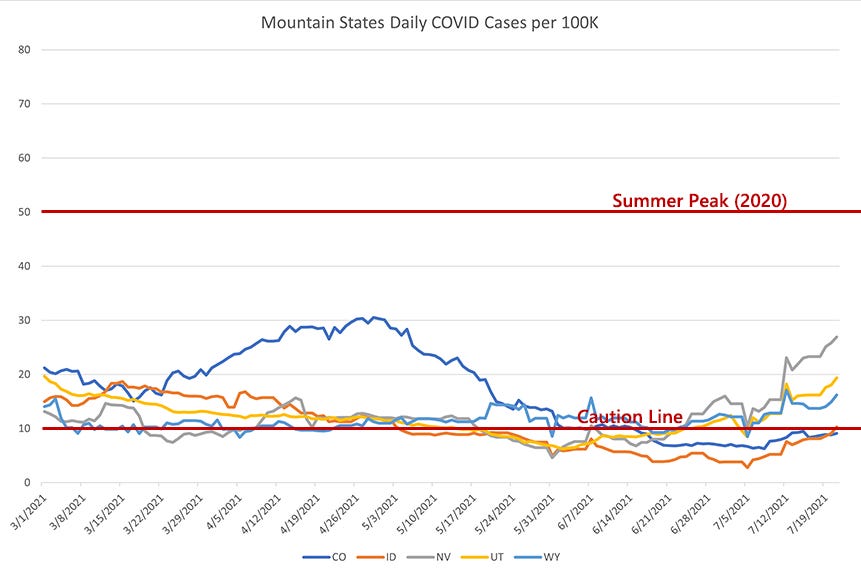




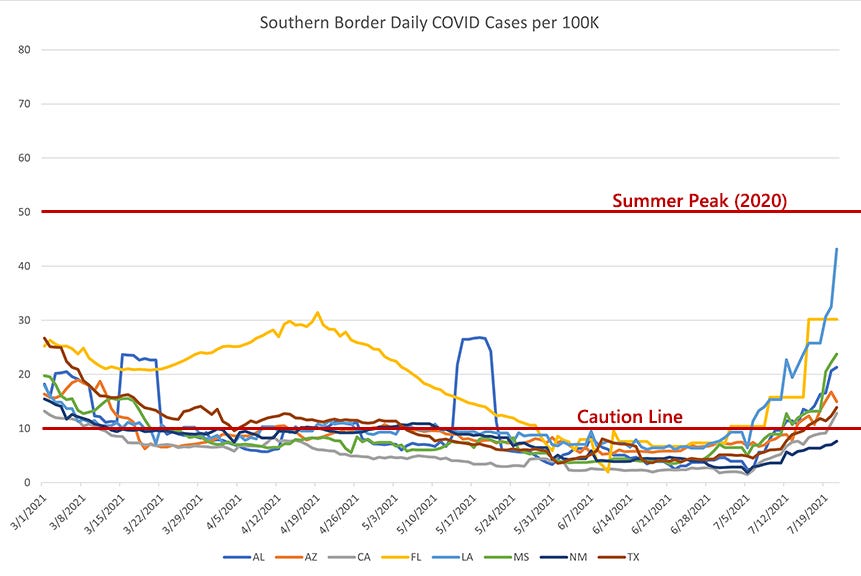





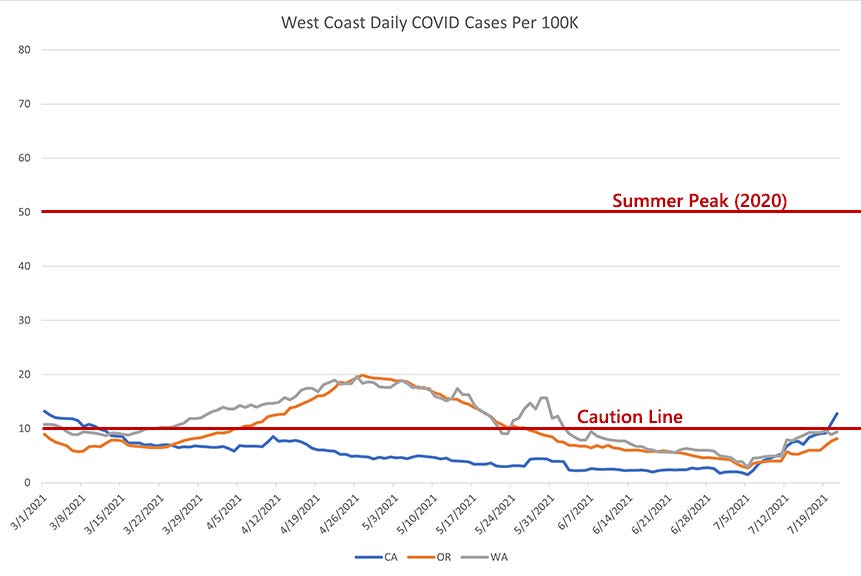


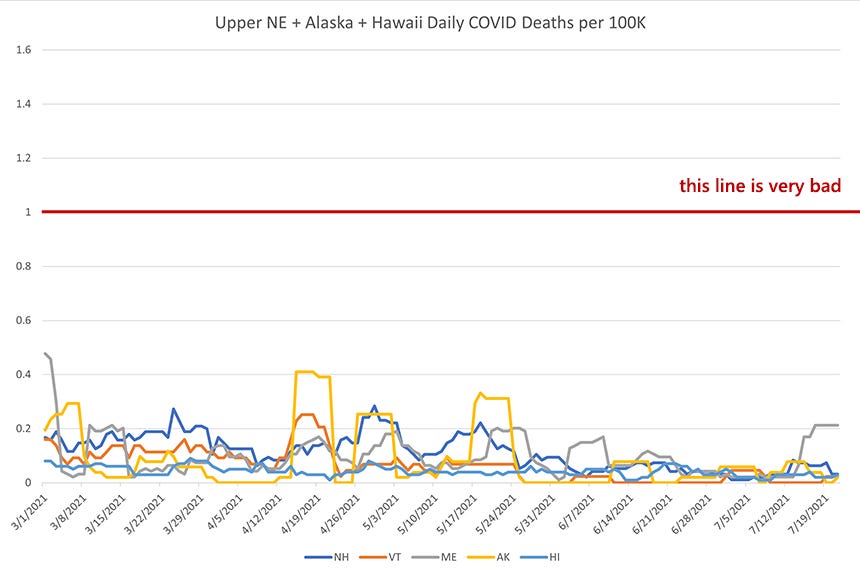
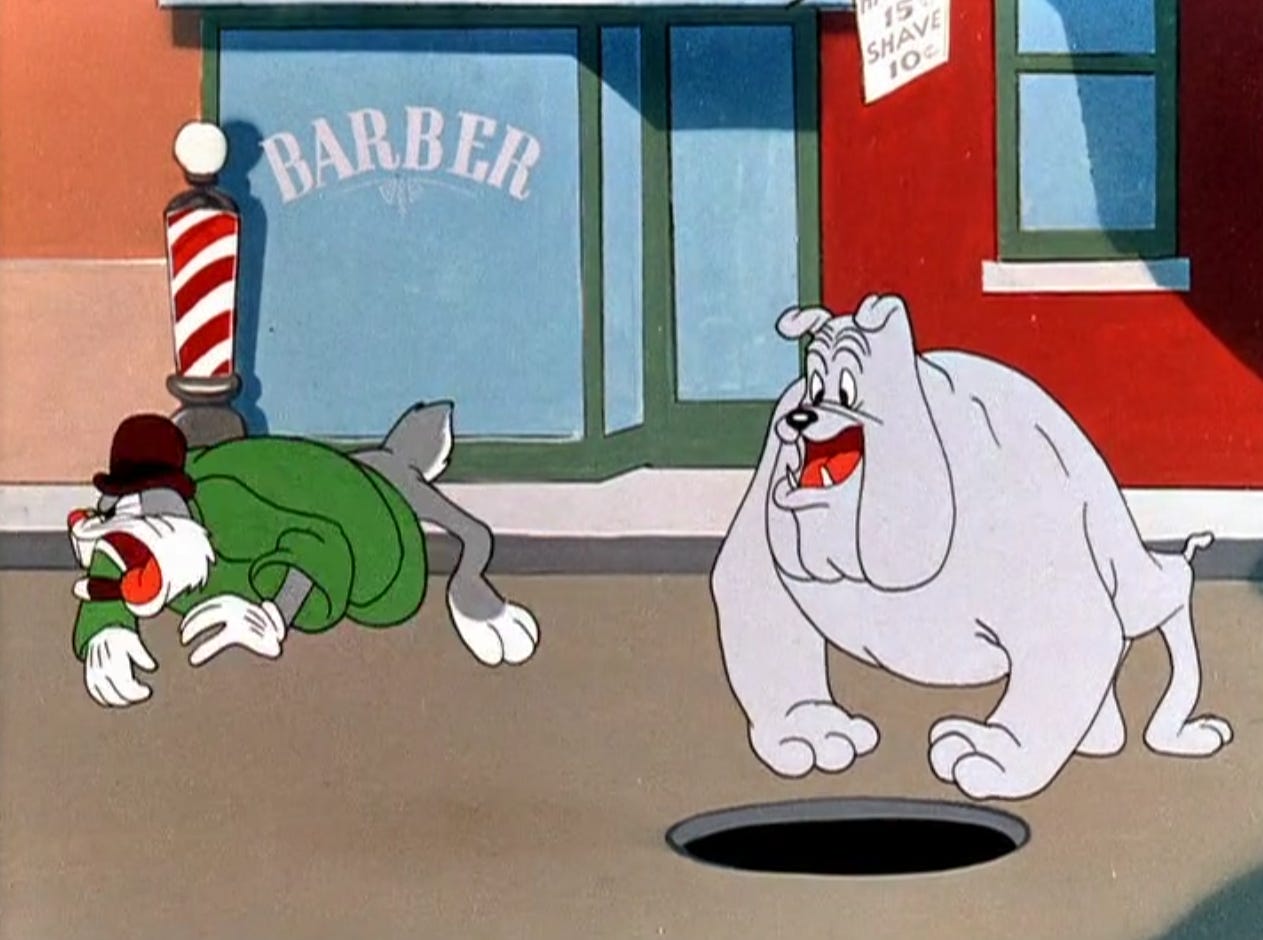
Thank you for again providing this analysis. I needed some sanity as my governor (KY) is once again taking to the podium to instill fear over the Delta variant surge. These are quotes from his news conference less than 24hours ago - "The Delta variant is the most aggressive form of COVID, that we have seen. If you are unvaccinated, it is the deadliest form of COVID that we have seen.” The Public Health Commissioner added, “Our positivity rate is going up. It’s getting closer to seven percent." The incidence rate they showed gave was 12.67 on Wednesday. My county is fairly representative with a 12.3 IR. We had a rolling average of 10-25 positives per day among those being tested for a county of close to 100,000. Next question - who is being tested and why?